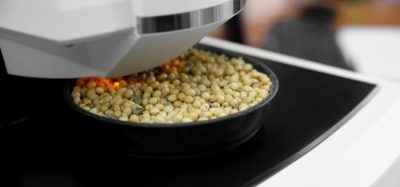New developments in low field NMR for the characterisation of food microstructure
- Like
- Digg
- Del
- Tumblr
- VKontakte
- Buffer
- Love This
- Odnoklassniki
- Meneame
- Blogger
- Amazon
- Yahoo Mail
- Gmail
- AOL
- Newsvine
- HackerNews
- Evernote
- MySpace
- Mail.ru
- Viadeo
- Line
- Comments
- Yummly
- SMS
- Viber
- Telegram
- Subscribe
- Skype
- Facebook Messenger
- Kakao
- LiveJournal
- Yammer
- Edgar
- Fintel
- Mix
- Instapaper
- Copy Link
Posted: 1 June 2009 | Matthieu Adam-Berret and François Mariette, Cemagref & Université européenne de Bretagne | No comments yet
Fats are present in most food products and they have a significant importance for fat-containing products such as chocolate and butter. The physical properties of fats depend on the polymorphic behaviour and inter-solubility of their major triacylglycerol components and the phase behaviour of these mixtures is of paramount importance for the food industry. Indeed, fat structures formed by their crystals determine the functional properties of fat-containing products such as their texture, plasticity and morphology. DSC and XRD are the two techniques generally used to characterise fats. Crystal size is another important parameter for determining the physical properties of fats because it affects the rheological properties and consequently modifies taste, graininess and texture.
Fats are present in most food products and they have a significant importance for fat-containing products such as chocolate and butter. The physical properties of fats depend on the polymorphic behaviour and inter-solubility of their major triacylglycerol components and the phase behaviour of these mixtures is of paramount importance for the food industry. Indeed, fat structures formed by their crystals determine the functional properties of fat-containing products such as their texture, plasticity and morphology. DSC and XRD are the two techniques generally used to characterise fats. Crystal size is another important parameter for determining the physical properties of fats because it affects the rheological properties and consequently modifies taste, graininess and texture.
Fats are present in most food products and they have a significant importance for fat-containing products such as chocolate and butter. The physical properties of fats depend on the polymorphic behaviour and inter-solubility of their major triacylglycerol components and the phase behaviour of these mixtures is of paramount importance for the food industry. Indeed, fat structures formed by their crystals determine the functional properties of fat-containing products such as their texture, plasticity and morphology. DSC and XRD are the two techniques generally used to characterise fats. Crystal size is another important parameter for determining the physical properties of fats because it affects the rheological properties and consequently modifies taste, graininess and texture.
The use of low-field NMR spectrometers in the food industry began in the 1970’s with the commercial availability of the first bench-top NMR systems. Several applications were developed during the following years, but they were limited to the determination of water and fat content and measurement of the solid fat index. Surprisingly, the number of applications did not increase much during the following twenty years. In 1992, the first International Conference on Applications of Magnetic Resonance in Food Science was organised and since that time, with the improvements in bench-top NMR characteristics, new applications have been put forward. One of the most well-known is droplet size measurement based on diffusion coefficient measurements. The use of NMR relaxation times was suggested, not only for determining water and fat content but also for investigating food structure. Furthermore, NMR is a non-destructive technique and can be used to perform dynamic measurements, for example with changing temperatures or for studies relating to storage time.
Determination of solid fat content is one of the most popular applications of NMR in the food industry. Nevertheless, this international reference method is based on very crude acquisition and data processing where a pair of data points needs to be obtained (one at 11ms, which corresponds to both the solid and liquid part, and one at 70ms, which corresponds to the liquid part only). Following the work of Van Duynhoven et al.1, Trezza et al.2 recently demonstrated that greater accuracy in the measurement of the solid fat content could be achieved when the full NMR signal is fitted with semi-empirical mathematical functions for solid, semi-solid and liquid components. An extension of this method has also been suggested in order to adapt the method to non-anhydrous fat products such as emulsions. Indeed, in emulsions the contribution of non-fat solid-like protons such as non-exchangeable protein protons to the solid phase has to be taken into account3. Here, we will discuss new results obtained with low-field NMR equipment for the characterisation of fats and the new prospects which result from these measurements.
Crystal polymorphism
The method of SFC determination developed at Unilever and based on the fitting of NMR signal decay which takes into account the relaxation time T2 and the signal intensity, can also be used to assess the polymorphic composition of fats. The results demonstrated that the NMR method was potentially the first technique to provide the amount of the solid and liquid phase and the polymorphic state of the lipid simultaneously2.
From an extended investigation on the effects of temperature and triacylglycerol chain lengths on the second moment M2, we showed the ability of NMR to determine the polymorphism of triacylglycerols regardless of temperature and chain length4. For different pure saturated triacylglycerols, a ratio of 1.5 to 2 between the second moments M2 of their β form and α form was observed (Figure 1).
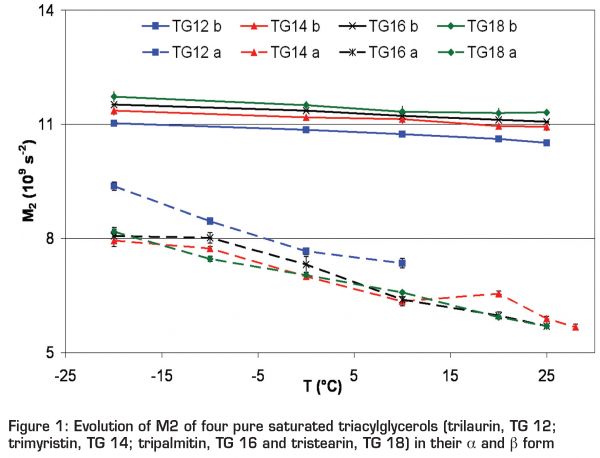

This difference between the M2 of the two forms was considered enough to determine polymorphism for pure triacylglycerols. However, as fats are complex mixtures of triacylglycerols, this method of determination of polymorphism was extended to the study of mixtures5. It could be observed that discrimination was possible in a mixture and that the polymorphic forms in the mixture could be quantified. The second moment is thus only sensitive to polymorphism and it could be a new probe in food to investigate polymorphism.
Crystal size thickness
Parallel to the development of this T2-based approach, an investigation on the behaviour of the spin-lattice relaxation time T1 from the crystallised fat phase was also carried out6. This study was based on the effects of storage time on the fat crystal network. The T1 of a model mixture consisting of a liquid triacylglycerol and a solid one was followed over time (Figure 2).
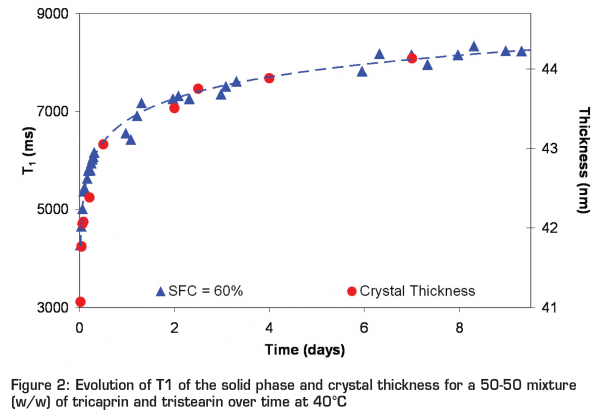

The evolution of T1 with storage time followed a power-law model which was related to the Ostwald ripening phenomenon, which corresponds to the melting of the smaller crystals to form larger ones. At the same time, it was verified that polymorphism (via M2 measurements) and SFC remained constant. The changes to the thickness of the crystals were determined by X-ray measurements in order to establish the correlation between T1 of the crystalline phase and crystal size. The two parameters followed exactly the same evolution as shown in Figure 2, establishing that the increase in T1 is related to the growth in the thickness of the crystals.
The sensitivity of the T1 relaxation time of the fat crystal organisation has also been observed in fat mixtures with added surfactant and in food emulsions. For example, wide variations in T1 were observed according to the cooling rate of milk fat7. A shorter T1 was observed for a faster cooling rate and the T1 was reduced when surfactants were added, compared to the T1 from the dairy fat without surfactant. In dairy emulsions, a change in T1 relaxation time of the fat crystal was observed according to the maturation temperature of the emulsion8. For a maturation temperature of 4°C, a narrow T1 distribution was obtained, whereas a bi-modal distribution was obtained for a maturation temperature of 12°C. Changes in the T1 relaxation time of the crystallised fat phase have also been reported in ice cream mix and ice cream9. The T1 of the crystalline phase thus seems to be a very interesting parameter for the investigation into the behaviour of food containing significant amounts of fat, since the fat crystal network confers to food its physical properties.
Crystal size network
After establishing that the T1 of the solid phase was related to the crystal size, the T2 of the liquid phase was measured over time in order to follow the consequences of such crystal growth on the liquid phase. In porous media, the T2 of the liquid phase depends on the interactions with the surface of the pores. Due to the surface relaxation mechanism, the relaxation times are shorter in pores with a high surface-to-volume ratio. The relaxation parameters are therefore used to obtain information on pore geometry. A mean discrete value of T2 of the liquid phase was determined and its developments as well as the changes to crystal thickness were followed over time (Figure 3). In this situation, the amount of liquid phase remained constant and the evolution only depended on the modifications to the specific surface area developed by the crystals.
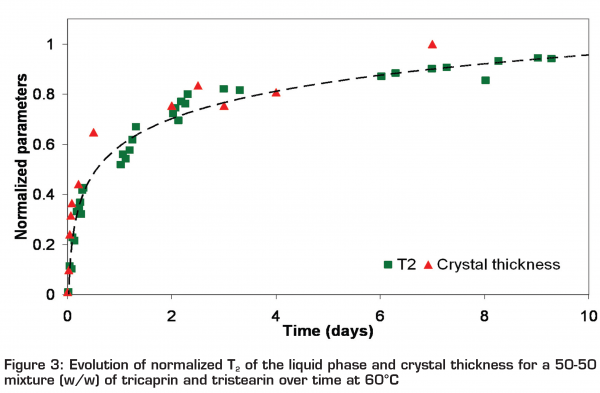

It was possible to note that there was a rapid increase of T2 during the first days and a slower increase subsequently. The T2 of the liquid phase were fitted by a power-law model as was the case for the T1 of the crystalline phase and the crystal thickness. It has already been proved that the specific surface area of tristearin crystals in paraffin oil decreases over time, as does the average crystal size. This change in T2 could thus be related to the decrease in the specific surface area of the fat crystals during storage and the fact that the change according to a power-law model was similar for the solid and the liquid phases confirmed this. Indeed, when crystals grew, the specific surface area decreased and thus led to an increase in T2 because the volume remained constant. Therefore, T1 of the solid phase provides information on the thickness of the fat crystals and T2 of the liquid phase provides information on the size developed by the crystals.
Crystal network porosity
Diffusion-NMR is widely recognised as a powerful method to obtain micro-structural information in emulsions and porous materials. The diffusion coefficient D of a liquid phase can be determined by Pulse Field Gradient NMR. The coefficient diffusion depends on the intensity g of the pulsed gradients and on the time of diffusion Δ. When the diffusion is restricted, for example by the droplet interface in emulsion, D becomes dependent on the diffusion time Δ, which is related to the size of the droplet. A routine PFG-NMR method was thus put forward for measuring droplet size distribution in water/oil or oil/water emulsions10,11,12. In porous material, for long diffusion times, when D becomes independent of Δ, it is possible to estimate tortuosity, which is inversely proportional to porosity. We have applied this technique to characterise the microstructure of the fat crystal network. Diffusion properties of fat in the liquid state can be useful to improve our understanding of the micro-structural modifications in the fat crystal network during manufacture and storage of high-fat-content products such as chocolate and butter.
The tortuosity of a mixture of liquid tricaprin and solid tristearin at 60°C in relation to SFC is shown in Figure 4. The tortuosity decreased with SFC. It dropped from 2.3 for 75 per cent SFC to 1.3 for 15 per cent SFC. Such values are comparable to those found for polymers and silica. Tortuosity being inversely related to porosity, it could be concluded that the fat crystal network was more porous at low SFC. NMR measurements thus proved to be effective for obtaining information on the porosity through diffusion coefficient measurements, but also on the sizes of these pores via T2 measurements.
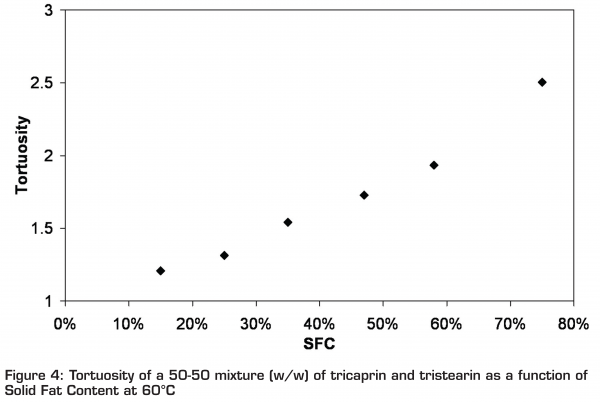

Conclusion
The physical characteristics of the fat crystal network, defined by the Solid Fat Content and the crystal structure, are determining for the mechanical and sensory properties of food containing a significant amount of fat. Low-Field NMR is currently used to determine the solid fat content, but it does not provide information on the structure of the crystalline network. Our goal is to develop and evaluate NMR methodologies based on the measurements of the relaxation and diffusion properties to characterise fat structure at different levels (Solid Fat Content, size and shape of the crystals). These new developments to the benchtop NMR open new opportunities in the characterisation of the fat system in dynamic conditions. For example, it is possible to observe how it evolves over time or under mechanical and thermal constraints. Recently, a specific mini-Couette cell was developed and introduced directly into the NMR tube in order to study crystallisation of fat samples under shear13.
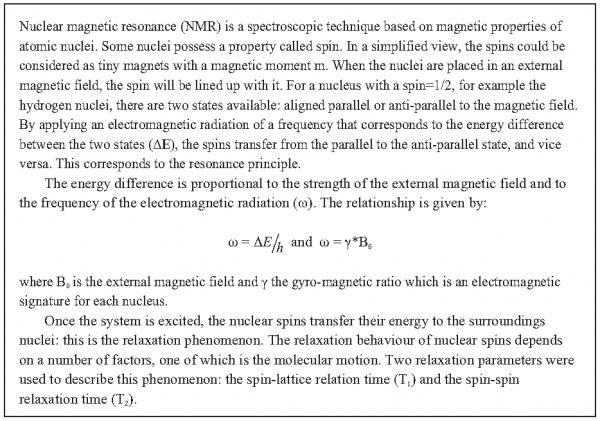

References
- Van Duynhoven, J., et al., Determination of MG and TG phase composition by time domain NMR. Journal of the American Oil Chemists Society, 2002. 79(4): p. 383-388.
- Trezza, E., et al., Rapid phase-compositional assessment of lipid-based food products by time domain NMR. Magnetic Resonance in Chemistry, 2006. 44(11): p. 1023-1030.
- Duval, F.P., J.P.M. Van Duynhoven, and A. Bot, Practical implications of the phase-compositional assessment of lipid-based food products by time-domain NMR. Journal of the American Oil Chemists’ Society, 2006. 83(11): p. 905-912.
- Adam-Berret, M., et al., Study of triacylglycerol polymorphs by nuclear magnetic resonance: effects of temperature and chain length on relaxation parameters. Magnetic Resonance in Chemistry, 2008. 46(6): p. 550-7.
- Adam-Berret, M., A. Riaublanc, and F. Mariette, Effects of crystal growth and polymorphism of triacylglycerols on NMR relaxation parameters. Part 2: A solid-solid study. Cryst. Growth Des., 2009.
- Adam-Berret, M., et al., Effects of crystal growth and polymorphism of triacylglycerols on NMR relaxation parameters. Part 1: Evidences of a relationship between the size of the crystals and spin-lattice relaxation time. Cryst. Growth Des., 2008.
- Ollivon, M., et al., Crystallisation of anhydrous milk fat: Influence of polymorphism and emulsifiers. Sciences Des Aliments, 2005. 25(5-6): p. 397-411.
- Riaublanc, A., et al., Impact of fat crystals on the foaming capacity and stability of whipped creams. Sciences Des Aliments, 2005. 25(5-6): p. 427-441
- Lucas, T., et al., NMR assessment of ice cream: Effect of formulation on liquid and solid fat. International Dairy Journal, 2005. 15(12): p. 1225-1233.
- Balinov, B., O. Soderman, and T. Warnheim, Determination of water droplet size in margarines and low-calorie spreads by nuclear magnetic resonance self-diffusion. Journal of the American Oil Chemists Society, 1994. 71(5): p. 513-518.
- Mooren, M.M.W., M.C.M. Gribnau, and M.A. Voorbach, Determination of droplet size distributions in emulsions by pulsed field gradient NMR, in Characterization of Food, A.G. Gaonkar, Editor. 1995, Elsevier: Amsterdam. p. 151-162.
- Goudappel, G.J.W., J.P.M. van Duynhoven, and M.M.W. Mooren, Measurement of oil droplet size distributions in food Oil/Water emulsions by time domain Pulsed Field Gradient NMR. Journal of Colloid and Interface Science, 2001. 239: p. 535-542.
- Mazzanti, G., E.M. Mudge, and E.Y. Anom, In situ Rheo-NMR measurements of solid fat content. Journal of the American Oil Chemists Society, 2008. 85(5): p. 405-412.






